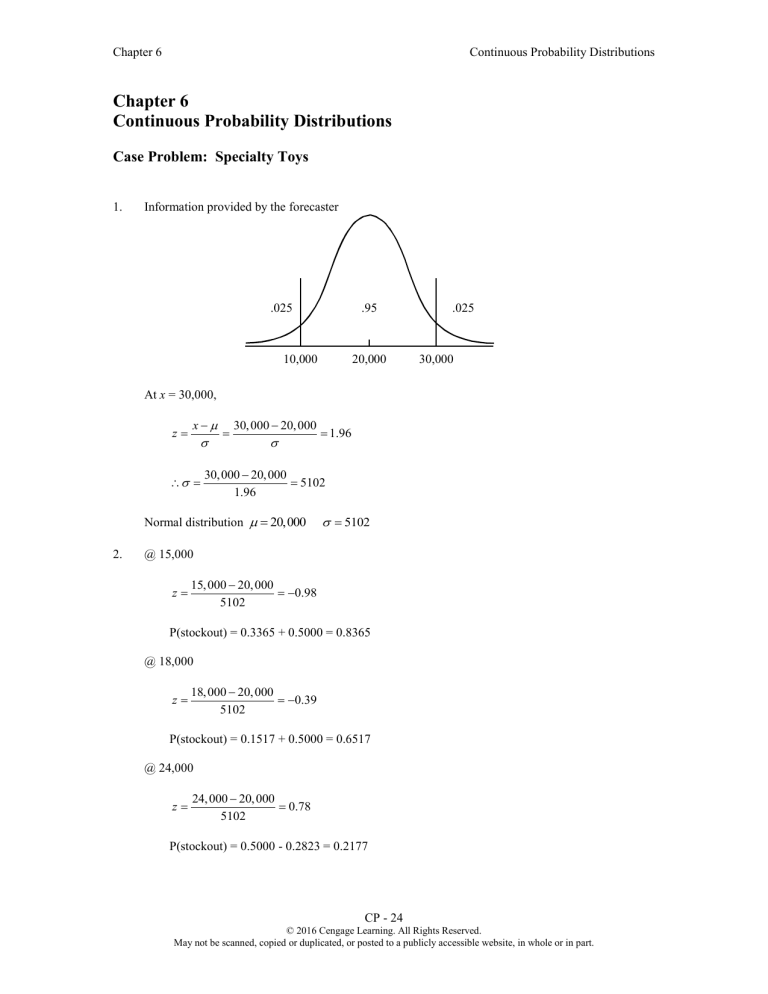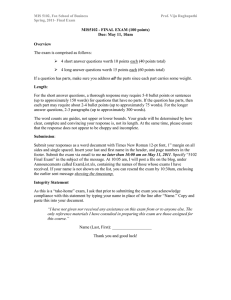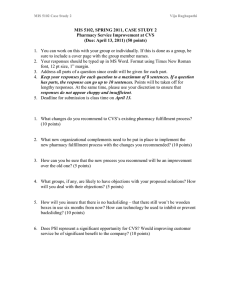
Chapter 6 Continuous Probability Distributions Chapter 6 Continuous Probability Distributions Case Problem: Specialty Toys 1. Information provided by the forecaster .025 .95 10,000 20,000 .025 30,000 At x = 30,000, z x 30, 000 20, 000 30, 000 20, 000 5102 1.96 Normal distribution 20,000 2. 1.96 5102 @ 15,000 z 15, 000 20, 000 0.98 5102 P(stockout) = 0.3365 + 0.5000 = 0.8365 @ 18,000 z 18, 000 20, 000 0.39 5102 P(stockout) = 0.1517 + 0.5000 = 0.6517 @ 24,000 z 24, 000 20, 000 0.78 5102 P(stockout) = 0.5000 - 0.2823 = 0.2177 CP - 24 © 2016 Cengage Learning. All Rights Reserved. May not be scanned, copied or duplicated, or posted to a publicly accessible website, in whole or in part. Chapter 6 Continuous Probability Distributions @ 28,000 z 28, 000 20, 000 1.57 5102 P(stockout) = 0.5000 - 0.4418 = 0.0582 3. Profit projections for the order quantities under the 3 scenarios are computed below: Order Quantity: 15,000 Sales Unit Sales 10,000 20,000 30,000 Total Cost 240,000 240,000 240,000 at $24 240,000 360,000 360,000 at $5 25,000 0 0 Profit 25,000 120,000 120,000 Order Quantity: 18,000 Sales Unit Sales 10,000 20,000 30,000 Total Cost 288,000 288,000 288,000 at $24 240,000 432,000 432,000 at $5 40,000 0 0 Profit -8,000 144,000 144,000 Order Quantity: 24,000 Sales Unit Sales 10,000 20,000 30,000 Total Cost 384,000 384,000 384,000 at $24 240,000 480,000 576,000 at $5 70,000 20,000 0 Profit -74,000 116,000 192,000 Order Quantity: 28,000 Sales Unit Sales 10,000 20,000 30,000 Total Cost 448,000 448,000 448,000 at $24 240,000 480,000 672,000 at $5 90,000 40,000 0 Profit -118,000 72,000 224,000 CP - 25 © 2016 Cengage Learning. All Rights Reserved. May not be scanned, copied or duplicated, or posted to a publicly accessible website, in whole or in part. Chapter 6 4. Continuous Probability Distributions We need to find an order quantity that cuts off an area of .70 in the lower tail of the normal curve for demand. 30% 70% 20,000 Q z = 0.52 Q 20, 000 z 0.52 5102 Q = 20,000 + 0.52(5102) = 22,653 The projected profits under the 3 scenarios are computed below. Order Quantity: 22,653 Sales Unit Sales 10,000 20,000 30,000 5. Total Cost 362,488 362,488 362,488 at $24 240,000 480,000 543,672 at $5 63,265 13,265 0 Profit -59,183 130,817 181,224 A variety of recommendations are possible. The students should justify their recommendation by showing the projected profit obtained under the 3 scenarios used in parts 3 and 4. An order quantity in the 18,000 to 20,000 range strikes a good compromise between the risk of a loss and generating good profits. While the students don't have the benefit of the following, a single-period inventory model (sometimes called the news vendor model) shows how to find an optimal solution. We outline that solution below. A single-period inventory model recommends an order quantity that maximizes expected profit based on the following formula: P(Demand Q* ) cu cu co where P(Demand Q* ) is the probability that demand is less than or equal to the recommended order quantity, Q * . cu is the cost of underestimating demand (having lost sales because of a stockout) and co is the cost per unit of overestimating demand (having unsold inventory). Specialty will sell Weather Teddy for $24 per unit. The cost is $16 per unit. So, cu = $24 - $16 = $8. If inventory remains after the holiday season, Specialty will sell all surplus inventory for $5 a unit. So, co = $16 $5 = $11. CP - 26 © 2016 Cengage Learning. All Rights Reserved. May not be scanned, copied or duplicated, or posted to a publicly accessible website, in whole or in part. Chapter 6 Continuous Probability Distributions P(Demand Q* ) 8 0.4211 8 11 0.4211 0.5789 Q* z = -0.20 z Q 20,000 0.20 5102 * Q* 20, 000 0.20(5102) 18,980 The profit projections for this order quantity are computed below: Order Quantity: 18,980 Sales Unit Sales 10,000 20,000 30,000 Total Cost 303,680 303,680 303,680 at $24 240,000 455,520 455,520 at $5 44,900 0 0 Profit -18,780 151,840 151,840 CP - 27 © 2016 Cengage Learning. All Rights Reserved. May not be scanned, copied or duplicated, or posted to a publicly accessible website, in whole or in part.






